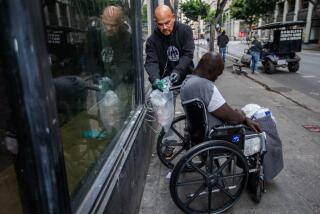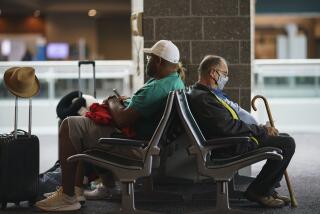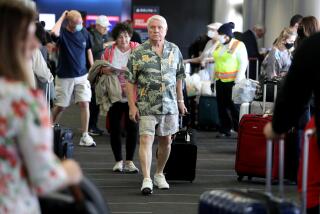Getting Air Up There for Fliers With Lung Disease
About 1.1 million people in the United States who have lung disease rely on supplemental oxygen, and about 750,000 of them are medically able to travel by plane, according to estimates from the American Lung Assn.
Getting to the destination comfortably, however, requires extra planning. First, travelers who use supplemental oxygen must find out from their physicians exactly what they need on board. Then they have to check in early with the airline because supplies must be ordered.
Under Federal Aviation Administration rules, for safety reasons passengers are prohibited from taking their own oxygen canisters on board, says Bill Mosley, a spokesman for the U.S. Department of Transportation.
Commercial airlines may provide supplemental oxygen to passengers, he says, and most do, but they are not required to do so.
Some carriers, in particular those specializing in short-hop flights, do not. In Los Angeles, America West and Southwest Airlines are among those that do not supply supplemental oxygen for passengers.
Policies vary among airlines that do offer oxygen to passengers who need it. American and United, for instance, request at least 48 hours’ advance notice and prefer additional notice if possible.
Charges for the oxygen are usually levied by flight segment (each takeoff-to-landing is a segment). American and United, for instance, charge $75 per segment.
Anyone who uses supplemental oxygen at sea level needs it while flying, says Dr. Henry Gong, a pulmonologist who also teaches at the USC School of Medicine. For other lung disease patients, he considers their health status and itinerary when deciding whether to prescribe in-flight oxygen. “A patient with chronic obstructive pulmonary disease, for instance, going from Los Angeles to Boston would probably need it,” says Gong, who is an advisor to the American Lung Assn. of California.
Lung disease patients who also are recovering from pneumonia or bronchitis would probably not be cleared for flying.
Passengers should know basic information about their oxygen needs, Gong says, because flight attendants are not trained in oxygen administration. “Be sure you know the flow rates recommended by your doctor, for instance,” Gong says.
Travelers must make arrangements for oxygen at their destination; it can be ordered from local oxygen suppliers.
Gong also reminds his patients with lung disease to be sure to use their inhalers and take other medications on schedule.
A brochure, “Safe Flying for People With Lung Disease,” is available from the American Lung Assn., telephone (800) LUNG-USA.
Healthy Traveler appears on the second and fourth Sundays of the month. Kathleen Doheny can be reached at kdoheny@compuserve .com.
More to Read
Sign up for The Wild
We’ll help you find the best places to hike, bike and run, as well as the perfect silent spots for meditation and yoga.
You may occasionally receive promotional content from the Los Angeles Times.






